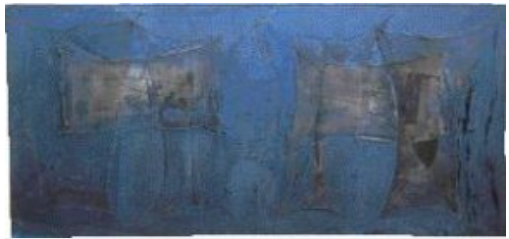Roman painter Franco Angeli died on this day in 1988 of AIDS. He embodied the Italian Pop Art movement and belonged to the so-calledPiazza del Popolo school of artists who frequented Rosati’s bar and gathered around the infamous gallerist Plinio de Martiis. His friends included Tano Festa and Mario Schifano, as they shared Angeli’s popular origins and communist-leaning political views. Angeli – better known to everyone simply as ‘Franco’ – was a self-taught artist. Born in the working class neighborhood of San Lorenzo in Rome, he was orphaned at the tender age of 13. He went to live with his older brother Otello, who was quite an influence, as he had strong leftist political views and later beccame the secretary of the Communist Party of Cinecittà. Franco did not finish school, but went straight to work, apprenticing at a barbershop, and picking up odd jobs at a laundry business. He began making art in the mid-1950s, as a way to respond emotionally to the devastation of WWII. Inspired by the dominant art movement art Informel, he created dark, thick impasto canvases, which he then covered with ripped and torn nylon stockings. During the 1960s his style shifted, and he became concerned with consumer icons and capitalist symbols.
In one of his social outings on an autumn evening in Rome, Franco met Jack Kerouac, who had been invited to Italy by his publisher, Mondadori. This chance encounter resulted in an artwork, “The Deposition,” despite the fact that neither spoke the other’s language. The artwork has only recently been found, after it was missing for four decades, and has been included in a recent exhibition of Franco’s paintings and photographs. The story goes that Franco also took Kerouac to see two Caravaggio paintings in the Church of Santa Maria del Popolo. Caravaggio was one of Franco’s three passions, according to his former lover Marina Ripa di Meana. The other two were stewed lamb and cocaine. His indulgent lifestyle got the better of him, and he passed away in Rome when he was only 53.
Human Skin as a Decorative Object, 1958, mixed media on canvas
Souvenir of Rome, 1964, mixed media on canvas
United States of America, 1965, enamel paint on canvas
Half Dollar, 1967, enamel paint on card
7AM, ca. 1969, mixed media on paper
Further Reading: Tugnoli, Andrea, and Livia Lancellotti. Franco Angeli. Pistoia: M & M, Maschietto & Musolino, 2001; Anselmi, Rolando. Franco Angeli: una retrospettiva. Roma: Galleria Delloro, 2008.

